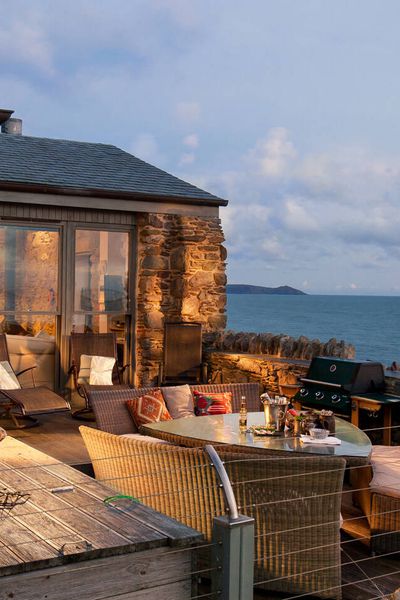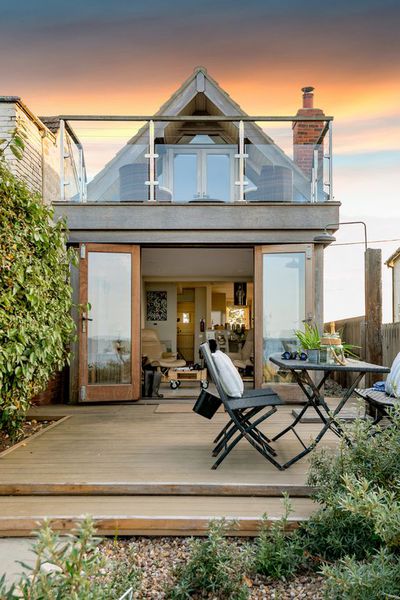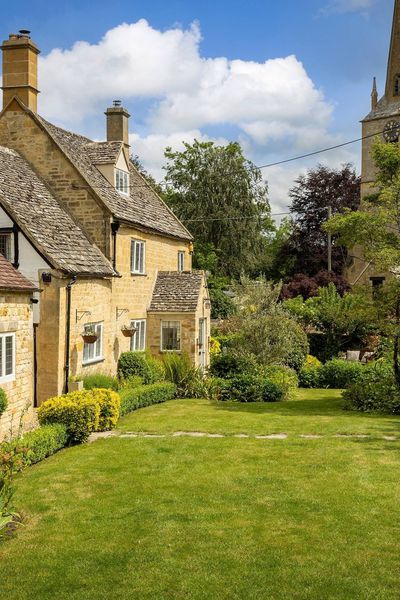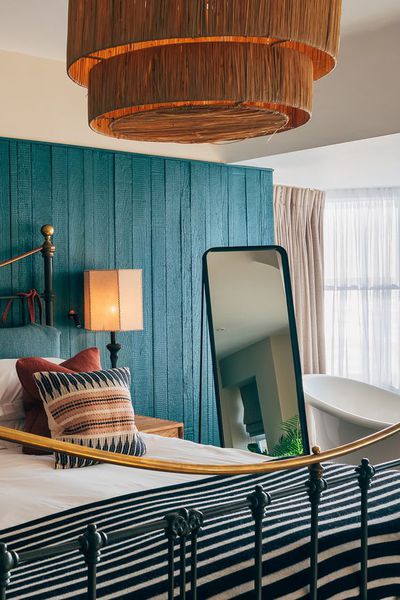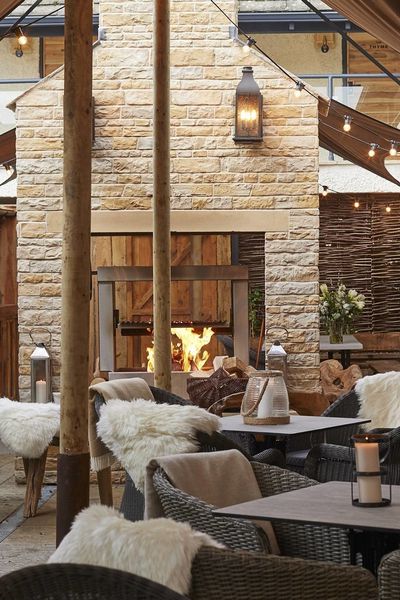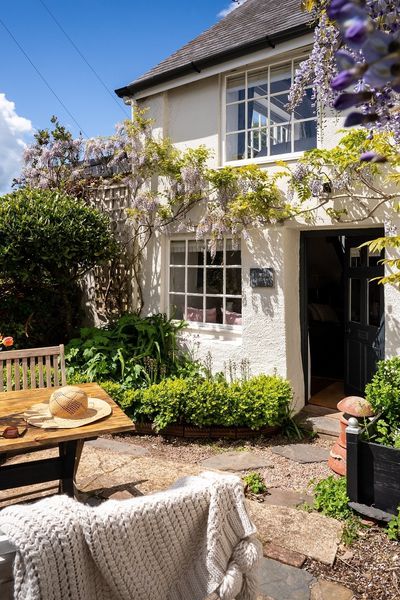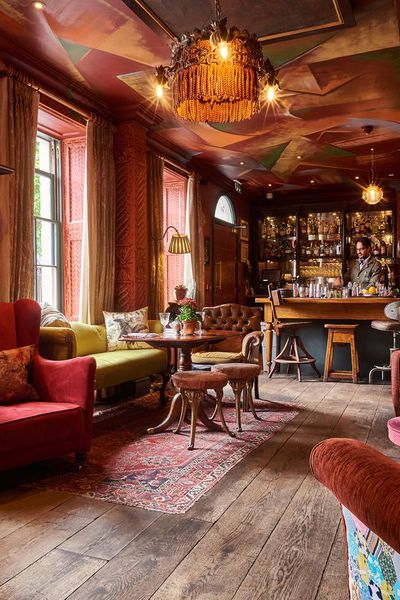
Royal security, mismatched columns and water sounds: The making of a country garden
Sawday's Expert
5 min read
Iford Manor is a place that feels rich with stories and deep with calm. Owners, Marianne and Will, kindly shared both with me on a visit to Rowley Cottage, at Iford Manor and gardens, along with some advice to apply to my own garden.
Luckily for Will and Marianne Cartwright-Hignett, Princess Margaret’s security detail wouldn’t allow her to buy Iford Manor. So, 60 years ago, Will’s mother bought it instead. Although it looks like a quintessentially Georgian house, with its elegant stucco front and trails of wisteria, nothing is quite as it seems at Iford. The house actually began life as a wool factory in the fifteenth century. A long single room above stables allowed cloth to be rolled out and checked for imperfections and the road and ford immediately in front of the house (deemed too close for Princess Margaret’s safety) allowed wool to be taken away for trade with Italian and Flemish merchants.
Tucked away in a tranquil valley between the Cotswolds and the Mendips, Iford Manor is reached by a steep narrow road at the end of which you are met by Brittania on the bridge and immediately enveloped by quiet, the only sounds coming from birdsong and the constant, reassuring flow of the weir. As Marianne says, “You don’t know which country you’re in, and you don’t know which period you’re in. It’s just deeply peaceful.”


This sense of peace and timelessness is largely thanks to architect and garden designer, Harold Peto, who lived at Iford from 1899 to 1933. Peto was the go-to designer for industrial millionaires and royalty, to the extent that the Cap Ferrat was nicknamed ‘Peto Point’ in Edwardian times. He travelled the world collecting antiquities and inspiration and the ethos behind his designs continues to inform how the garden is experienced today.
“He went to Japan, China, Europe, North America, and he brought back plants with him, as well as knowledge,” explains Marianne. “He was fascinated by different cultures and their ideas of beauty. And so when we go around the garden, what you see is the antiquities that he’s brought back from those places and some of the plants too. The definition of beauty from all these different cultures comes together in a sort of melting pot.”
“His design ethos was that flowers alone aren’t good enough, that they cannot cast the mind back in the way that masonry and stones can because memory needs that structure.”


As we walk around the house towards a traditional English rose garden, unusually framed with Italianate barley-twist columns, Marianne points out other objects amongst the flowers that work as hooks for memories and stories. There are millstones nodding to the Manor’s wool trade history; windows saved from a Venetian palace undergoing renovation; and ancient Roman and Florentine sculptures.
She also draws our attention to the sounds and scents. “The things you smell and hear, they’re all really important experiences. Maybe you’ve been on holiday to France, and you then go into a garden and you just get that smell of lavender. It is very powerful and I think the trick to a lot of the design is those memories. It would be very personal to each person, depending on what their memories are, but it’s having a design that can evoke those memories and really just transport you away from the world.”
Our walk through the garden takes us through Japanese cherry orchards, the trees gifted by the Japanese government; woodland blanketed by wild garlic; Italianate cloisters home to Byzantine, Roman and Medieval treasures, as well as Iford’s summer jazz festival; and past a tiny chick toy in the hands of a statue, left behind from Marianne and Will’s children’s Easter egg hunt. The sense of calm is wonderful.
“I think some people treat it like a church,” Marianne reflects. “There’s a lot of healing. I know that people come here and they leave feeling refreshed and renewed in quite a spiritual way. I think it’s because you can just escape and get back to nature, which is harder and harder to find, especially so close to cities and in today’s world where I just feel life is so stressful. It’s all those memories. It transports you elsewhere. But it also just allows you time, proper time.”


Creating Iford in your own garden
Hoping to hear the secrets of coaxing calm and telling stories in my own considerably smaller garden, I asked Will and Marianne to tell me more about the design principles at play at Iford and how I might adapt them.
Embrace pluralism
“The first is this idea that it’s okay to blend, it’s alright not to be purist about design. Standing here, you’ve got this set of extremely English rose terraces, this very Tuscan set of terraces with magnolia, cyprus, juniper, rosemary and lavender; then down here you’ve got this sort of Spanish patio courtyard. There is this lovely blending of these different spaces, and yet somehow they’re all very harmoniously tied together. Harold Peto travelled and brought all those other people’s ideas back here and embedded them into this very English substrate, and that, I think, is something anyone can do, go and learn, go travelling, go to Rome, go to Sicily. Come back, find a piece of old artefact in the reclamation yard, and think, do you know, if I stuck that on there next to this, they’ll muddle along. So pluralism in design is acceptable, and I would say positive something to strive for.“
Don’t show everything at once
“The second thing, which I think Iford delivers really well, is this idea that you shouldn’t show the whole picture all at once. We’ve all been to those Victorian rectory gardens with an acre of garden, but it’s basically a lawn with a border around the outside and you can get a thousand people in there for the village fete or whatever but actually, it looks tiny because you’ve got no concept of scale. When you don’t know how big something really is, everything shrinks. So you’ve got this idea of not showing everyone the whole picture. So standing right here on a steep slope, we can see terraces stretching out ahead of us, but if we just come four yards up the hill and look back we start to realise, this one isn’t really a complete terrace, but our mind thought it was. Those ones are actually much longer than we thought, but now we can’t see them. And then you look up here and you realise that that little bit of random colonnade actually turns out to be something really interesting. You’re being drawn on.”
Guide people with sound
“This is the third thing Iford can teach, which is the importance of sound, the fourth dimension of gardening. We’ve got birds at this time of year, but we’ve also got water for when the birds are a bit fed up with heat in August, and they’ve all said, enough, we’ve done our breeding, we’re off. So they go and hunker down under some shade, the water takes over. It gives that sense of something. You can’t see it yet, so you want to know where it comes from and suddenly, there it is this little blue pond. So the sound draws you on. And now you’ve arrived at somewhere, and you weren’t really thinking about climbing the hill.”
Borrow your landscape
“The borrowed landscape is something anybody can do, because even if you’re sat next to an industrial estate, there will be something that you can borrow from your neighbour to set something in context. It might be that, because it’s an industrial estate, you’ve drawn that industrial heritage into the garden using metals and steel chairs. So something that’s relevant here is that we’re in Italian-style terraces but that’s a really English landscape. It couldn’t really be anywhere else, except maybe it could, because the poplars make you think of France. So maybe actually it’s Southern Mediterranean, but it isn’t because it’s ash, chestnut and beech and all of that, so it’s always playing with you. That’s what Iford does, it plays with you. “


As we walk back through the garden to the café, admiring an ancient column capital sat at the top of an avenue framed by spring tulips, Will reflects, “It’s a five-dimensional garden at least, because you have the three dimensions, and sound, and then you’ve got time too. Time is in two dimensions, actually, because you’ve got this season, as gardeners think about seasons, but you’ve also got this 50 year cycle, this 100 year cycle, and all the objects, some of which are thousands of years old. I mean, there’s that lovely barley twist column here that’s 2,000 years old, and you can go touch it. We are only part of it. Just the next bit of the story.”
Guests at Rowley Cottage at Iford Manor can enjoy the gardens at Iford every day until 4pm – even on days when it’s not open to the public.
Book a stay at Rowley Cottage at Iford Manor >
Receive our guides, destination ideas and insider travel tips straight to your inbox.
Sign up >Share this article:
You might also like
Pasture, pizza and back to the pub: Askham Fell and Lowther Estate walk

Jen & Sim Benson
5 min read
Discover the new generation of B&Bs

Christopher Wilson-Elmes
Sawday's Expert
5 min read
A trip 25 years in the making

Christopher Wilson-Elmes
Sawday's Expert
5 min read
